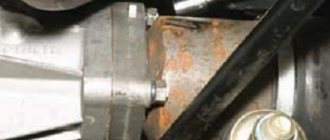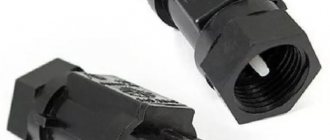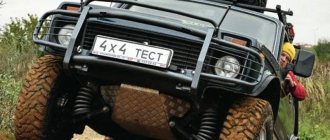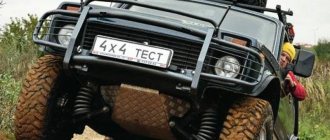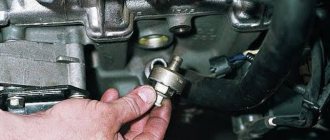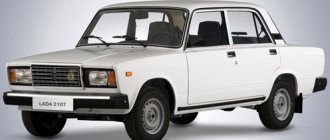The VAZ 2121, in other words, “Niva”, entered mass production in the 70s of the last century. This car belongs to the class of off-road passenger cars. In the history of the domestic automobile industry, Niva became the first car whose design used all-wheel drive. Let's take a closer look at the transmission device. This should be done in order to understand why, given its almost 40-year history, the Niva transmission differs from many other similar vehicles equipped with all-wheel drive and the ability to shift in the classical way or using a viscous coupling.
The transmission in the Niva family (2121, 2131) is designed in such a way that all-wheel drive is supplied to 4 wheels. Also characteristic is the presence of a center differential. The transmission includes a gearbox, a transfer mechanism, a pair of cardan shafts, and both axles. A characteristic feature of the 2131 model is its elongated body. Otherwise, the main similarities with the first model can be traced throughout. Torque is transmitted from the engine through the gearbox to the transfer case, and it, in turn, transmits torque to the axles.
Then it goes through the cardan shafts to the gearboxes. The front gearbox transmits torque to the wheels through the differential and constant velocity joints. Likewise for the rear, also protruding, driving wheels. It is precisely because the torque is distributed to 4 wheels simultaneously that the drive is called full drive. The designation is as follows – 4WD. Another domestic car, designed on a similar principle to the Niva, is the UAZ.
Differential
This mechanism is a kind of distributor of traction forces coming from the motor to the wheels. An important feature is that the latter have the ability to rotate at different speeds. The importance of having a differential mechanism is due to the fact that during turning maneuvers, the wheel located inside makes fewer revolutions when compared with the number of turns of the outer wheel.
In the absence of a differential mechanism, this would cause detrimental consequences, such as wear and damage, because the result would be the following: when turning, one wheel would be in a slip state, and the second would simply rub against the road surface. The design features of the Niva transmission provide for the presence of 3 differentials. They are located in each of the bridges and in the transfer mechanism.
When the car moves on a flat road and in a straight line with differentials, the traction force is divided equally between all 4 wheels. If there is insufficient adhesion of the wheels to the surface or slipping occurs, the differentials will redistribute the load on the slipping and sliding wheel so that the first receives more force, and the second, accordingly, less.
We have already mentioned UAZ. Despite many similarities, it should be understood that the VAZ’s all-wheel drive is made in the “pat-time” style. This means that when connected, the axes are firmly connected to each other, and rotation occurs at the same speeds. This device imposes some restrictions on the use of all-wheel drive - it can only be used in cases where road conditions allow slipping. In cases with hard asphalt roads and highways, it is recommended to switch the car to single-drive mode.
Turning on all-wheel drive.
The use of blocking will be justified in the following cases:
- If there is a possibility of wheel slipping, in areas with poor surface conditions,
- If there is a lack of engine thrust at high speeds,
- When driving on roads with loose surfaces, snow, ice.
You should also take into account some features of the Chevrolet Niva, namely, the helplessness of the transmission when hanging diagonally. In this mode, the wheels begin to spin, so if necessary, you need to dig under the wheel or make an embankment under the raised axle.
Differential locking
Sometimes you can come across a misconception about why a small handle is needed next to the shift lever on a Niva. Some car owners believe that it is needed to connect front-wheel drive. However, the front-wheel drive of this car is permanently connected. As is the rear one. Cars of the Niva family have permanent all-wheel drive. The handle actually serves to switch the operating modes of the differential of the transfer mechanism.
In the “forward” position, the differential operates as usual, but if you move it back, the differential is locked, and the forces from the motor are applied to the differentials of the axles, which makes the drive more rigid. It is worth noting that there are also special types of locks for front and rear axles.
In theory, when used in conditions where the car is stuck, it will be able to overcome the obstacle if there is sufficient traction on at least one wheel. In this case, it is better to lock the differential before overcoming an obstacle, but never after entering an area that is difficult to overcome. This application of locking will avoid wear and damage to the transmission.
The history of the creation of the Niva car
In the post-war years, the type of domestic SUVs was limited mainly to the GAZ cars available at that time. The country was “healing the wounds” inflicted by Hitler’s Nazis in the field of infrastructure and had to be content with what it had.
gas 67
But in the 70s, there was a need to provide small-class SUVs to the population of rural areas. The relevance of the issue has not lost force to this day. A huge number of rural areas do not have access roads or even crushed stone road surfaces.
The government of the USSR set a task for automobile factories to create a passenger car with off-road capability and comfort that was not inferior to the products of the Fiat concern, the contract with which was already at the final stage.
Initially, all the units, components and electrical equipment from the already developed and mastered one were installed on the promising model, and it looked like an ordinary passenger car and there was nothing specific, reminiscent of an SUV. And the interior was practically the same as the VAZ-2106.
Work on the creation continued and in 1972 the first sample of the E-2121 was tested; a name had not yet been assigned to the machine at that time, and in 1974 the first 15 pre-production samples were released and they were named in honor of the children of the machine’s creator P.M. Prusov. – Natalia and Irina, as well as the children of the first chief designer V.S. Solovyov. - Vadim and Andrey. Thus, the first letters of the names of the children of the creators of the SUV formed the name of the domestic passenger cross-country vehicle “NIVA”.
Niva carburetor 2121
A series of downshifts
You can often encounter the following type of misconception: switching the rear handle can increase the power characteristics of the motor. But this is not true. It serves to change the gear ratio between the engine and the wheels. By increasing it, the traction forces on the wheels will increase. There is also a reduction gear in the dispensing mechanism.
Its operation can be controlled using the rear handle. When we shift the lever back, we will have a gear ratio of 2.135 - this is a low gear. It is recommended to downshift such a gear only when the car is stationary and the clutch is depressed. Despite the fact that the manual does not contain such a restriction, novice and inexperienced Niva drivers are not recommended to switch while driving, since the Niva transfer mechanism is not equipped with a synchronizer.
Transmission Chevrolet Niva
Chevrolet Niva transmission: 1, 3 — front wheel drives; 2 — front axle gearbox; 4 — clutch; 5 — gearbox; 6 — front driveshaft; 7 — gear shift lever; 8 — intermediate shaft; 9 — transfer case control lever; 10 — transfer case; 11 — rear propeller shaft; 12 - rear axle. Chevrolet Niva transmission: 1, 3 — front wheel drives; 2 — front axle gearbox; 4 — clutch; 5 — gearbox; 6 — front driveshaft; 7 — gear shift lever; 8 — intermediate shaft; 9 — transfer case control lever; 10 — transfer case; 11 — rear propeller shaft; 12 - rear axle.
Tips for owners
To make driving your car comfortable, read some important points:
- The usual, standard arrangement of the front and rear handles is forward and backward, respectively. Movement in this mode can and should be carried out in areas characterized by even and smooth surfaces.
- Locking the differential by switching the front handle to the rear position is best on roads characterized by increased slipperiness. This measure will give Niva stability. It is worth understanding that after overcoming the problem area, the handle will need to be returned to its original position.
- As noted earlier, downshift should be activated before a potential obstacle, but not while the car is already stuck.
- It is worth understanding that activating the lock when the vehicle is stationary is sometimes impossible, even if the clutch is depressed. This may be caused by the clutch teeth hitting the gear teeth. In this case, you can try to activate the lock by starting to drive slowly and make a slight turn. If problems arise with disabling the lock, it is recommended to perform the same procedure with the clutch depressed and the steering wheel slightly rocked.
Disabling the front axle in the field
There is nothing fundamentally complicated in the design of the multiplier, except that it itself is not attached to the main gearbox as on more modern all-terrain vehicles. Intermediate driveshafts extend from the transfer case to the manual transmission. The rest of the device is represented by gears, satellites and bearings. The design also includes a free differential with locking.
We recommend: How to check the performance of the vacuum brake booster
Is it necessary to modify the VAZ 4×4 Niva transfer case?
Cheviniva in 4x2 mode (disable all-wheel drive), leaving only.
If the lock does not turn on using the specified method, do not use excessive force. How to disable the immobilizer on a VAZ. Just repeat the entire sequence of actions from the beginning.
Switching to a lower gear is also allowed without stopping the Niva completely, but this can only be done by experienced drivers. The fact is that the transfer case, unlike the gearbox, does not have synchronizers installed. Changing from a lower gear to a higher gear while the car is moving is undesirable, although it is allowed in extreme cases.
It is not recommended to keep the center differential of the wheels in locked mode at all times, especially when driving on asphalt roads, as this will not only lead to increased fuel consumption by the vehicle and poor handling, but also to the breakdown of expensive transmission components.
It is preferable to enable forced blocking in various modifications of the Niva in the following situations:
- The blocking must be turned on in advance if you have to overcome a difficult route.
- On sharp climbs uphill or when driving downhill.
- While crossing terrain with a top layer of sand.
- When you have to drive on snow drifts or an icy road.
Wheel locking is not necessary when driving quietly on a flat road within the city. Grip on asphalt surfaces will be decent, and traction will be distributed evenly by default.
Rules for applying blocking on Niva
To ensure that the locking mechanism lasts for a long time, use the following rules:
- It is necessary to switch the transfer case when the Niva does not move.
- The differential can also be engaged while the vehicle is moving.
- To ensure efficient and long-term operation of the device, it is advisable for the Niva driver to turn on the lock from time to time. Once a week in winter is enough.
Also interesting: How to eliminate vibration of a VAZ-21213 transfer case
Where is the lever responsible for switching located? Pay attention to the area between the wings located in front, there are 2 levers there. One makes it possible to change gears at the gearbox, the other successfully controls the transfer case.
The basis of the transfer case is a gearbox, which includes 2 stages. The control lever comes directly from it, you can move it forward and backward - this is how the gear is changed on the Niva. The direction of movement of the lever to the left and right allows you to activate the differential lock and vice versa to disable it.
Why is downshift needed?
It is difficult to imagine a transfer case without the main functional component - a reduction gearbox. Positioning the lever in the rear direction reduces the transfer case value to 1.2.
By fixing the lever at the front, the gear ratio can be increased to 2.1. The lever in neutral indicates gear ratio 0.
To use the lock installed on the Niva effectively, use the following recommendations from experts:
- When driving on good quality road surfaces, install the front transfer handle at the front and the rear at the rear.
- The front handle is moved back if the road becomes slippery. Once the slippery area has been passed, switch the levers to normal mode.
- If the Niva is stopped, the lock may not engage when the clutch is depressed. This occurs due to the alignment of the teeth with the gear teeth. What should you do in this case? Moving as if on a turn, engage the lock. The differential will turn and the gear teeth will come closer to the teeth. If turning off is difficult, do it while the vehicle is moving, maintaining a minimum speed and squeezing the clutch.
